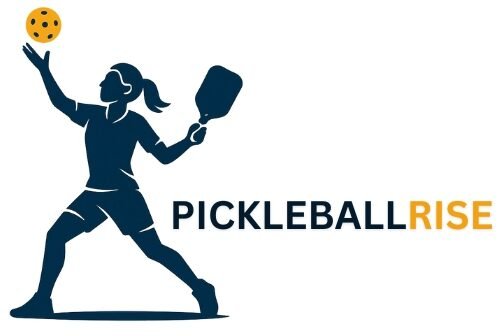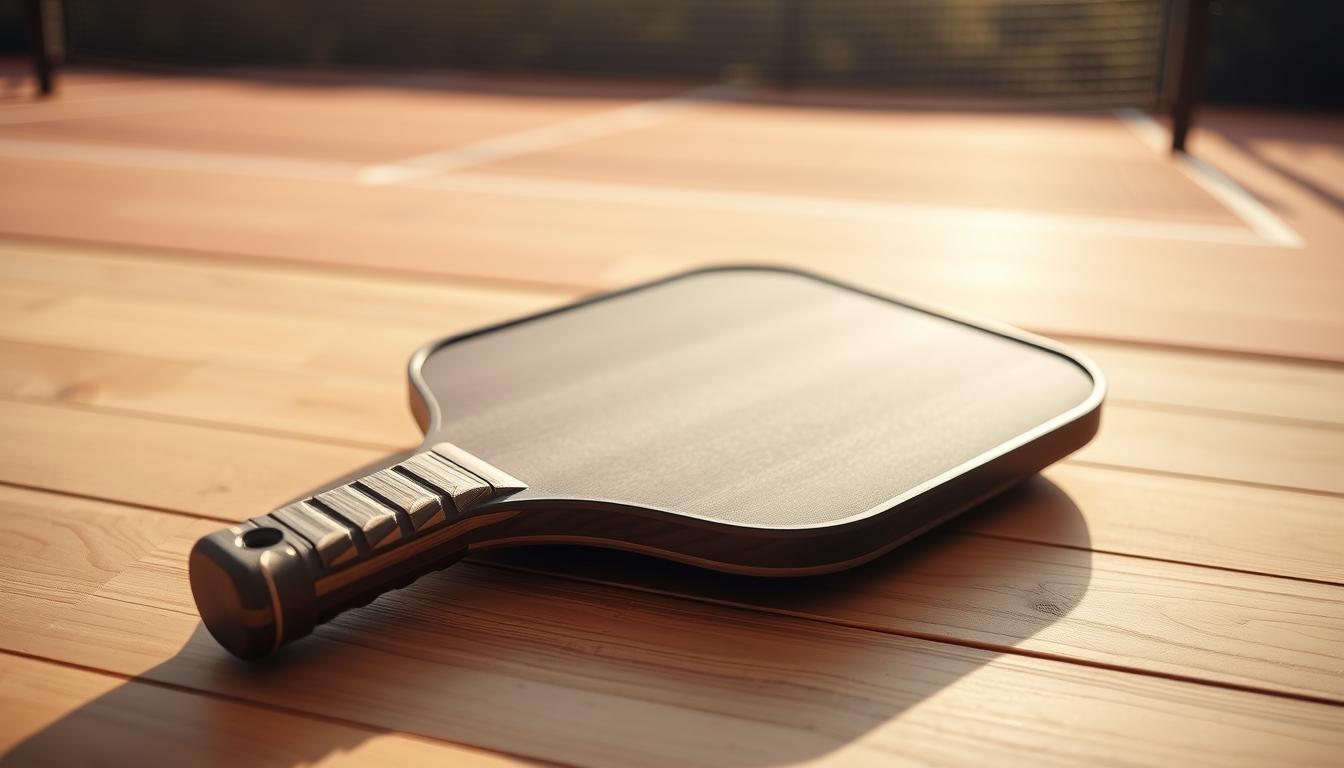What Is a Good Pickleball Paddle? Ultimate Picks & Buying Guide
Do you remember the first time a paddle felt right in your hand? It was that moment when a clean dink clicked and you felt confident to step up. You might wonder, what makes a good pickleball paddle and why do two paddles that look similar play differently?
The market is full of choices. Brands like Selkirk, Paddletek, Engage, and Wilson offer many models. There are also cheaper knock-offs. Marketing promises a perfect mix of power and control, making it hard to choose the right paddle.
This guide helps you cut through the hype. It focuses on five key specs: core material, paddle shape, facing layup, weight distribution, and construction method. You’ll learn the best features to look for and how they affect your game.
Whether you want a simple guide or a detailed look at paddles, this article is for you. You’ll learn to read spec sheets, compare models, and choose a paddle that suits your game. It’s about finding the right paddle, not getting caught up in brand noise.
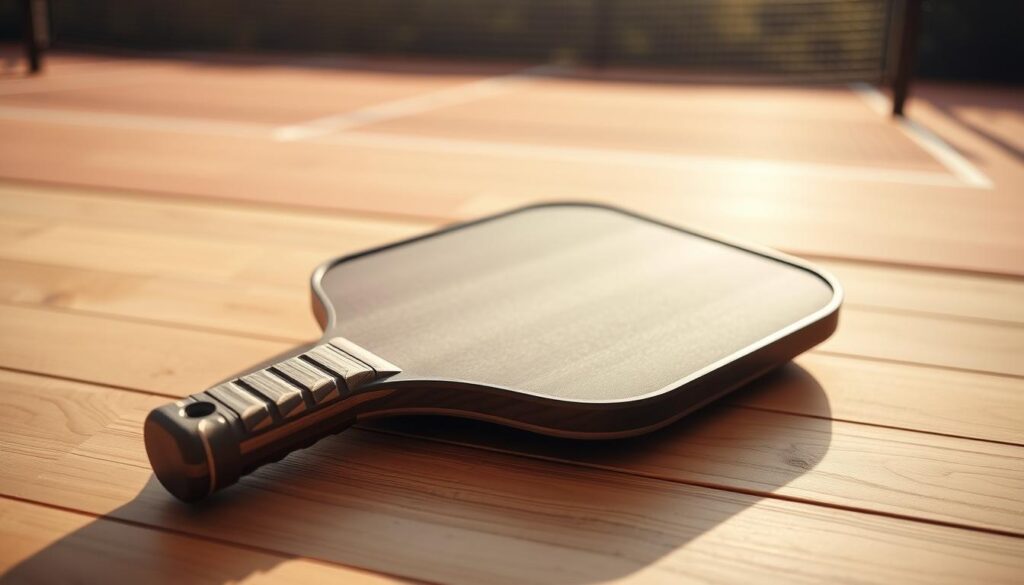
what is a good pickleball paddle
A good pickleball paddle fits your skill, style, and body. It should boost your strengths and hide your weaknesses. For power, choose a stiff face and dense core. For control and touch, go for a soft core and forgiving face.
Core material and thickness affect how the paddle feels and responds. The face’s layup and material change how it pops and spins. Shape and size impact reach and sweet spot size. Weight and balance influence swing speed and arm comfort. Grip size and handle length help with control and injury prevention.
Start by testing core material and thickness, along with weight distribution. Then, fine-tune with shape and facing to get the right feel, power, and forgiveness.
There’s no one good pickleball paddle for everyone. High prices don’t always mean better tech. Read reviews and compare specs before buying.
Brands like JOOLA, CRBN, Engage, and Bread & Butter are often tested and discounted. Use databases and reviews to find the right paddle for you.
| Component | What to prioritize | Why it matters |
|---|---|---|
| Core material & thickness | Polymer vs foam; thickness choice | Controls dwell time, power, and vibration |
| Facing material & layup | Carbon, fiberglass, or composite layups | Determines spin potential and surface stiffness |
| Weight & distribution | Static weight and swingweight balance | Feels heavier or lighter during swings; affects control |
| Shape & dimensions | Widebody, elongated, hybrid options | Alters sweet spot, reach, and forgiveness |
| Grip size & handle length | Circumference and short vs long handles | Comfort, wrist control, and two-handed play |
| Construction method | Cold pressed to full foam cores | Changes durability, consistency, and feel |
Top pickleball paddles in 2021 set trends still seen today. Now, affordable paddles offer many of these features at lower prices.
Practical takeaway: test paddles in person when you can. Compare core feel and swingweight first, then refine by shape and facing. Use pickleball paddle reviews to narrow options and confirm the best features for your game.
Core materials and thickness: how they affect feel and performance
Understanding core material and thickness is key to feeling the court. The core material affects power, control, and durability. Small changes in thickness alter the sweet spot and pop.
Polymer (polypropylene) cores explained
Polypropylene honeycomb cores are popular. Brands like Selkirk, Paddletek, and Onix use cells in sizes like 6mm, 8mm, and 10mm. Larger cells, like 10mm, offer more rebound but less consistent bounce and smaller sweet spot.
Smaller cells, like 6mm, provide a denser feel and better control. The 8mm cell balances power and consistency, making it a favorite among casual players. Thinner walls mean more pop, while thicker walls offer more control. But, polymer density is often not listed, so testing is key.
Foam cores and the 2025 developments
In 2025, solid foam cores became popular, like the CRBN TruFoam Genesis series. Foam cores offer a softer impact and tend to last longer than polypropylene cores.
Foam’s formulation and patterns affect its performance. Some foams improve stability and reduce vibration, while others aim for a livelier feel. Expect ongoing improvements as companies refine their products.
Core thickness trade-offs
Paddle core thickness ranges from 10mm to 20mm. The most common are 14mm and 16mm. A 16mm core feels softer, has a larger sweet spot, and absorbs pace better, making shots easier to control.
A 14mm core is firmer, offering more pop and offense. It has a smaller sweet spot and less plow-through. A two-millimeter difference can significantly change feel, so try different models.
- Prioritize core type and paddle core thickness over cosmetic features when choosing a paddle.
- Consider polymer vs foam cores based on whether you want a livelier pop or a softer, durable feel.
- Match thickness to your style: thicker for control and comfort, thinner for attack and touch.
Paddle shape and dimensions: reach, sweet spot, and forgiveness
USAP rules say a paddle can’t be over 24 inches long and wide. Makers choose to make paddles longer or wider to change how they feel and play. Knowing these choices helps pick the right paddle for your game.
There are three main types of paddles. Each has its own strengths and weaknesses that affect how well you can hit the ball.
Widebody, hybrid, and elongated shapes
Widebody paddles are usually 16″ by 8″ or a bit shorter. They offer a big sweet spot, steady play at the net, and easy movement. This makes them great for returns and volleys.
Hybrid paddles are about 16.25″ long and 7.5–7.7″ wide. They aim to balance reach and forgiveness. They’re good for players who need a paddle for dinks, serves, and baseline play.
Elongated paddles are longer than 16.5″ and about 7.5″ wide. They give you more reach, spin, and power. But, they’re heavier and have a smaller sweet spot, needing better technique.
Which shape suits your game
If you’re new or like steady control, a widebody paddle is for you. It helps with off-center hits and makes learning dinks and blocks easier.
Hybrid paddles are best if you want one paddle for many situations. They’re good for casual players and many intermediate players.
For extra reach and spin, choose an elongated paddle. You’ll get more power and control but need better technique because of the smaller sweet spot and heavier head.
| Shape | Typical Dimensions | Primary Benefits | Who Should Consider It |
|---|---|---|---|
| Widebody | ~16″ x 8″ | Large sweet spot, forgiving, stable at net | Beginners, many intermediates, anyone who values control |
| Hybrid | ~16.25″ x 7.5–7.7″ | Balanced reach and forgiveness, versatile | All-around players, recreational competitors |
| Elongated | >16.5″ x ~7.5″ | Extra reach, spin and power, more head-heavy | Advanced players, power and spin specialists |
Facing materials and layups: carbon, fiberglass, kevlar, and titanium
Before choosing a paddle, understand how facings affect feel and performance. Different materials change control, power, and sustain. Manufacturers adjust layups to match cores and shapes for the desired paddle behavior.
Material characteristics and player impact
Fiberglass pickleball paddle faces are bouncy and give strong pop on drives. They offer fast ball speed on aggressive swings but have a smaller sweet spot. This bounciness can make the impact feel harsh to some players.
Carbon fiber paddle faces, a type of graphite, have a larger sweet spot and better touch. They provide clean control on dinks and volleys while still offering power on bigger swings. Look for reputable weaves like T700 for consistent feel and durability.
A kevlar paddle offers a balance between carbon and fiberglass. Kevlar or aramid layers add punch without excessive harshness. Brands use kevlar as a top layer or mix it with carbon to tune responsiveness and color options.
Titanium paddle facings, using a polyester weave, aim for softer impact with reduced pop compared to pure carbon. This softer response is great for players who want control without losing too much power.
Common layup examples and what they produce
Manufacturers arrange layers to blend control and pop. A CCF layup (carbon, carbon, fiberglass) keeps the face controlled on short strokes while activating fiberglass for extra speed on full swings.
CFC (carbon, fiberglass, carbon) exposes fiberglass closer to the surface for quicker pop on moderate swings. This layout can feel livelier across more of the face.
CCC (carbon, carbon, carbon) prioritizes a wide sweet spot and steady control. You trade a touch of raw pop for predictability and feel, which suits precision players.
Blends with kevlar or titanium let manufacturers soften the impact, reduce harsh feedback, or add color and texture options without losing structural strength.
Beware of lower-quality facings
Cheap paddles might claim “carbon” or “graphite” but use low-grade fibers or minimal layup quality. These facings can wear fast and feel inconsistent. Look for specific materials like T700 carbon or detailed layup descriptions to avoid marketing talk.
When comparing graphite vs. composite paddles, focus on facing grade, not just the label. Facing quality affects durability, playability, and how predictable a paddle feels over time.
Use the facing type and layup notes along with core and shape info to narrow choices. This approach helps you find a paddle that matches your stroke, whether you prefer a fiberglass pickleball paddle for extra pop, a carbon fiber paddle for control, a kevlar paddle for hybrid feel, or a titanium paddle for softer impact.
Weight, swingweight, and twistweight: true feel vs static weight
Choosing a paddle is more than just looking at the weight. The feel of a paddle comes from its mass in the head, handle, and edges. It’s important to consider both paddle weight and grip size. A heavier grip or thicker overgrip can change how comfortable the paddle feels during long games.
Start by looking at static weight categories. Light paddles (about 7.2–7.7 oz) are great for quick reactions at the net. Midweight paddles (roughly 7.8–8.4 oz) offer a balance of power and control. Heavyweight paddles (8.5 oz and up) help drive the ball but can cause arm fatigue and reduce finesse.
Small static weight differences, like 0.1 oz, don’t always affect how a paddle feels on the court. Swingweight and paddle swingweight are more important for real-world feedback. Swingweight measures how hard it is to swing the paddle from the handle. Higher swingweight paddles feel heavier and can add power but slow down your swing.
Twistweight, or paddle twistweight, shows how hard it is to rotate the paddle around its long axis. Higher twistweight paddles are more forgiving and have a larger sweet spot. Many players start with swingweight around 112–118 and twistweight above 6 for a balanced feel.
Shape also plays a role. Elongated paddles have higher swingweight, often 116–124, but lower twistweight. Hybrid shapes usually have swingweight around 113–118. Widebody paddles have lower swingweight, around 108–114, but higher twistweight and stability.
Two paddles with the same static weight can feel different. This is because one might be head-heavy or have more mass in the edges. Manufacturers adjust this by adding foam, making faces wider, or using heavier edge guards. This changes swingweight and twistweight without affecting the static weight much.
You can also adjust the balance of your paddle. Adding lead tape to the handle, head, or edges changes swingweight and twistweight. Changing your grip or adding an overgrip affects paddle weight and grip size. This changes how the paddle feels during quick volleys and serves.
| Category | Static Weight (oz) | Typical Swingweight | Typical Twistweight | Player Benefit |
|---|---|---|---|---|
| Lightweight | 7.2–7.7 | 100–112 | 5–7 | Fast reaction, ideal for net play; less mass behind drives |
| Midweight | 7.8–8.4 | 112–118 | 6–7.5 | Balanced power and control; best for most players |
| Heavyweight | 8.5+ | 118–140 | 6–8 | More drive and easier power generation; greater arm load |
| Elongated Shape | Varies | 116–124 | 5–6 | Extra reach and pop, less forgiveness |
| Hybrid Shape | Varies | 113–118 | 6–7 | Mix of control and reach; versatile for many styles |
| Widebody Shape | Varies | 108–114 | 6.5–8 | Large sweet spot and stability; easy to adjust weight |
Grip size and handle length: comfort, control, and injury prevention
Choosing the right grip size and handle length changes how you play. It affects your comfort, control, and injury risk. Small changes can make a big difference.
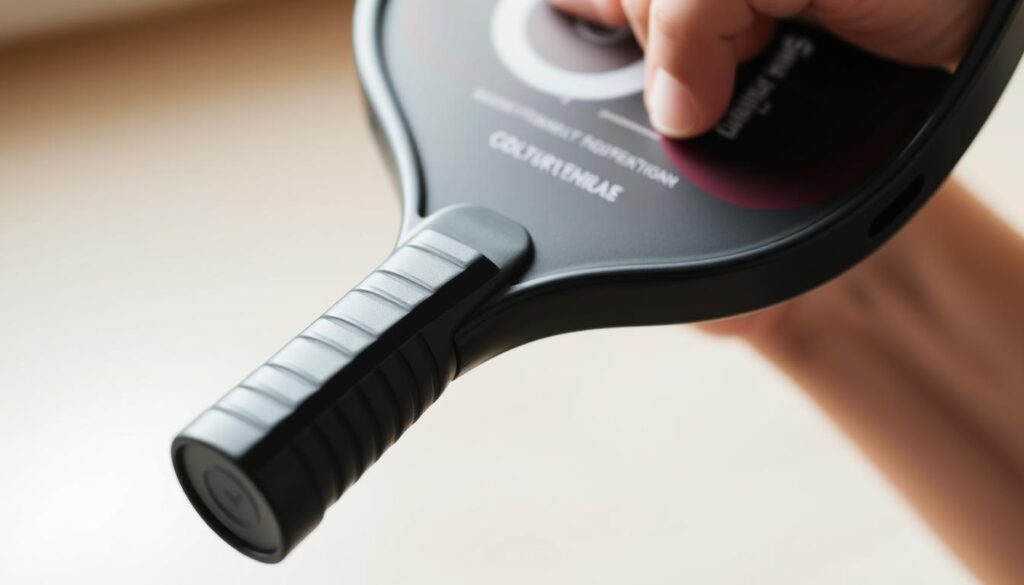
Grip circumference recommendations
Grip sizes range from 3 3/8″ to 4 3/8″. Most players prefer 4 1/8″ to 4 1/4″. If your hands are smaller, try 3 5/8″–4″. Larger hands might need 4 3/8″ or more.
The right paddle grip is key for wrist action, shot accuracy, and injury prevention. A grip that’s too small can lead to wrist motion and fumbling. A grip that’s too large can reduce wrist control and limit shot variety.
Handle length and two-handed shots
Handle lengths range from 4″ to 6″. Short handles are good for quick wrist feel and widebody paddles. Longer handles are better for two-handed backhands and volleys.
Consider your use of two-handed shots when choosing handle length. Players who mix strokes might prefer a mid-length handle for balance.
Making adjustments with overgrips and replacement grips
Overgrips are easy to add for a slight size increase. They also improve sweat absorption. They’re a quick fix between sessions.
Replacing the base grip offers a bigger size change. It can also affect handle length and paddle balance. Remember, a new grip can change feel and swingweight.
| Hand size | Recommended grip circumference | Typical handle length | Best adjustment |
|---|---|---|---|
| Small hands | 3 5/8″–4″ | 4″–4 1/4″ | Overgrip for minor changes |
| Average hands | 4 1/8″–4 1/4″ | 4 1/4″–5″ | Try both overgrip and replacement grip |
| Large hands | 4 3/8″+ | 4 3/4″–6″ | Replace base grip if needed for size |
Construction methods and generations: cold pressed to full foam cores
Understanding a paddle’s construction can tell you a lot. It shows how it feels, how long it lasts, and its balance between control and power. Here, we’ll explain the main types so you can find the right one for your game.
Cold pressed paddles are the classic choice. They have layers glued to a honeycomb core, with a guard around the edge. This makes them feel soft and control-focused, lasting well under regular play.
In 2023, a new method was introduced. It adds foam around the rim using heat and pressure. This makes the edge stiffer and the paddle more stable, but still control-oriented.
Then, in 2023, full thermoforming came along. It fuses layers to a carbon edge and fills the edge with foam. This makes the paddle stiffer, leaning towards power and stability.
2024 brought wider foam edges. Brands like JOOLA made paddles with a bigger foam perimeter. This changes how the paddle feels and adds power, depending on the foam’s density.
The full foam core generation started in 2025. It uses a continuous foam interior instead of honeycomb. Paddles like CRBN TruFoam Genesis promise to keep their shape longer and feel richer as the tech improves.
Newer doesn’t always mean better for everyone. Gen 1 and Gen 1.5 paddles are great for control and lasting long. Gen 2 and Gen 3 are more about power and weight. Gen 4 is still new but looks promising for feel and durability.
Here’s a quick guide to help you choose. Think about what you want in touch, power, and durability. Match these with the paddle’s construction.
| Generation | Typical Build | Play Traits | Durability Notes |
|---|---|---|---|
| Gen 1 | Traditional facing + polymer honeycomb core (cold pressed) | Control-oriented, plush touch | Proven longevity under normal use |
| Gen 1.5 | Cold pressed base with light thermoforming and foam perimeter | Control with added stability | Good durability; foam adds edge protection |
| Gen 2 | Full thermoforming, carbon perimeter, injected edge foam | Power and stiffness; stable at impact | Durable, but stiffer layups can show wear differently |
| Gen 3 | Thermoforming with widened dual-foam edge (example: JOOLA styles) | Boosted power, varied perimeter weighting | Edge foam can change impact response over time |
| Gen 4 | Full foam core replacing honeycomb (full foam core) | Enhanced feel, consistent response as tech matures | Promising durability; subject to ongoing testing |
Choosing the right paddle for your skill level and playstyle
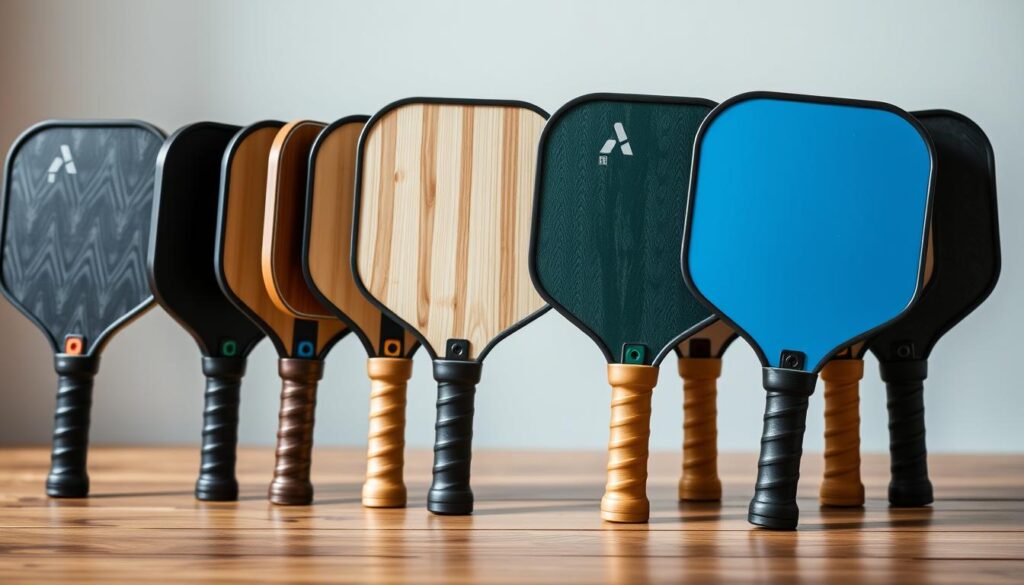
First, figure out your skill level: beginner, intermediate, or advanced. Your skill should guide your choice, but also think about growing. Focus on feel and control first, then consider weight, shape, and facing to meet your goals.
Beginner recommendations
Beginners should start with forgiving shapes like widebody or hybrid. A midweight paddle, around 7.8–8.4 oz, offers stable control and enough power for learning strokes. A thicker core, about 16mm, widens the sweet spot and reduces mishits.
Polymer or polypropylene cores are good choices. Entry-level composite or fiberglass facings are affordable, lasting around $50–$100. They’re durable for shared courts. Aim for a medium grip size, 4 1/8″–4 1/4″.
Look at warranties from brands like Selkirk, Paddletek, and Onix when shopping. These brands offer solid beginner models with good coverage and support.
Intermediate player guidance
Next, focus on weight distribution. Notice swingweight and twistweight to see how the paddle swings and handles off-center hits. Try both 14mm and 16mm cores to see if you prefer extra pop or more control.
Carbon fiber facings offer a good balance of power and touch for many intermediate players. For more power, add lead tape to the edge or handle. This adjusts balance without changing your grip size.
Use reviews and spec sheets to compare models. Filtering by swingweight numbers from popular brands helps you find the right feel. This way, you can compare based on actual feel, not just marketing.
Advanced and power/spin specialist advice
Advanced players often seek thinner cores like 14mm or special blends for more pop and crisp response. Elongated shapes increase reach and leverage for power and spin. However, they reduce the sweet spot size.
Look for high-grade facings like T700 carbon and detailed swingweight/twistweight specs. Textured layups or special coatings help with spin. Choose a construction that matches your preferred crispness or softness.
Be careful not to follow pro choices without trying them. Many pros prefer elongated paddles, but hybrids or widebodies might fit better for most players.
| Skill Level | Recommended Shape | Core Thickness | Weight & Grip | Typical Facing |
|---|---|---|---|---|
| Beginner | Widebody or hybrid | 16mm | 7.8–8.4 oz; 4 1/8″–4 1/4″ grip | Fiberglass or basic composite |
| Intermediate | Hybrid or slightly elongated | 14mm or 16mm (test both) | 7.6–8.6 oz; adjust with overgrip or lead tape | Carbon fiber common for balance |
| Advanced / Power-Spin | Elongated or tailored shape | 14mm or specific foam blends | Varied; precise swingweight matters | High-grade carbon (T700+), textured layups |
How to read a paddle spec sheet and use reviews to decide
Start by treating a spec sheet like a checklist. Look for facts that match your game. Key numbers and materials show what to expect on the court. Use this guide to quickly scan a spec sheet and compare it with hands-on reports.
Key specs to prioritize on a spec sheet
Focus on core material and thickness first. Look for polymer versus foam and common sizes like 14mm or 16mm. Static weight gives a basic feel. Swingweight and twistweight offer better insight into maneuverability and stability when available.
Shape and dimensions reveal reach and sweet spot size. Facing materials and layup details name carbon, fiberglass, or kevlar and how layers are stacked. Grip circumference and handle length affect comfort and stroke mechanics.
Construction method and generation hint at durability and feel. Cold-pressed boards differ from full thermoformed and full foam cores in response and edge resilience. Warranty length and brand reputation are useful supporting signals.
Interpreting marketing claims and brand noise
Ignore vague phrases like “perfect blend of power and control.” Seek measurable claims such as swingweight ranges, carbon type like T700, or cell size data for polymer cores. Those specifics are verifiable in independent tests.
Be skeptical of low-cost paddles that claim premium materials. Facings and carbon grades vary. High price with a short warranty can be a red flag. You should prefer clear, testable specs over buzzwords.
Using paddle reviews and databases
Check independent reviewers and paddle databases that publish swingweight, twistweight, and teardown photos. Reviewers at sites that measure cell structure or use x-rays give useful context you can compare to the spec sheet.
Compare multiple pickleball paddle reviews for consistent notes on feel, sweet spot, and durability. Demo programs at local pro shops or club swap events cut through guesswork. When demos aren’t possible, align the spec sheet key specs with the reviewer consensus to pick a model that matches your priorities.
| Spec | Why it matters | What to look for |
|---|---|---|
| Core material & thickness | Affects touch, power, and dwell time | Polymer 14mm–16mm or foam; match to your control vs power needs |
| Static weight | Initial feel and fatigue potential | Light (7.0–7.4 oz) for control, mid (7.5–8.1 oz) for balance, heavy (8.2+ oz) for power |
| Swingweight / Twistweight | Real-world maneuverability and stability | Swingweight ~112–118; twistweight above 6 preferred for less torque on off-center hits |
| Shape & dimensions | Reach, sweet spot, forgiveness | Widebody for forgiveness, elongated for reach and power; check length x width |
| Facing & layup | Spin potential and surface stiffness | T700 carbon, fiberglass layers, or kevlar; search for specific layup notes |
| Grip & handle | Comfort and stroke mechanics | Measure grip circumference and handle length; plan overgrips if needed |
| Construction method | Durability and general feel | Cold pressed vs thermoformed vs full foam; use this to predict longevity |
| Warranty & brand | After-sale confidence and likely longevity | Longer warranties and trusted brands such as JOOLA, Engage, CRBN signal reliability |
Conclusion
Choosing the right pickleball paddle is all about matching it to your game and body. First, decide if you need power, control, or spin. Then, look at the core material, thickness, weight, and grip size to find the best fit.
Use spec sheets and reviews to compare paddles. Hybrid or widebody shapes are good for most players. Elongated paddles are best for those needing more reach. Always test paddles and consider the brand’s reputation and warranty.
Look for a paddle with a core and facing that match your stroke. It should have balanced swingweight and a comfortable grip. The shape should fit your playing style. New tech like full foam cores and face materials can improve performance.
Remember, equipment helps but doesn’t replace skill. Improve your technique first. Then, choose gear that supports your growth and comfort. This way, you’ll find a paddle that works now and adapts as you get better.
